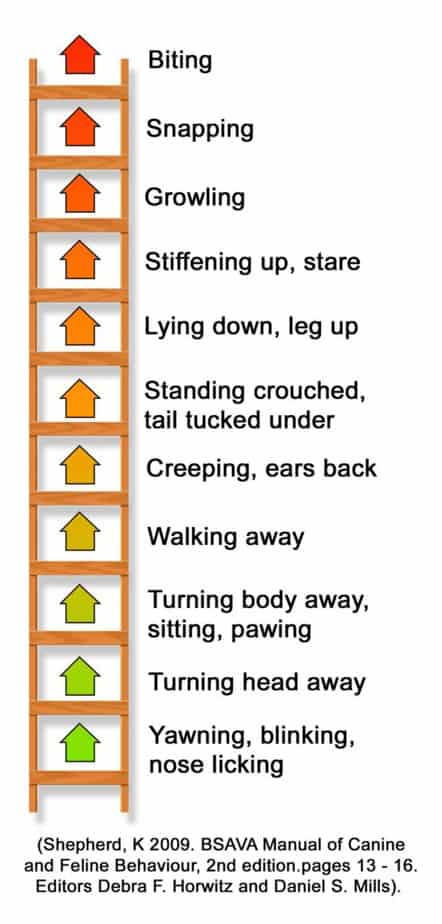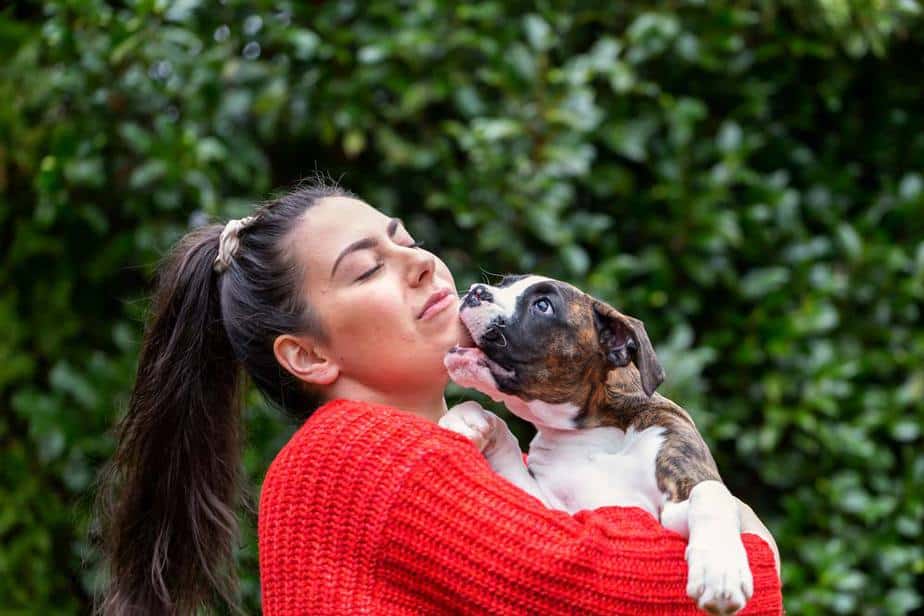If you’re seeing signs of aggression in your new Boxer puppy, it can be disconcerting or uncomfortable, and even scary! You might be wondering why your Boxer puppy is being aggressive or out of control, as well as how long their aggression will last and if you can train aggression out of your dog.
In this article, we will cover why your Boxer puppy is being aggressive or displaying “out of control” behaviors, as well as how to develop a solution that works for you.
Why is my Boxer puppy being aggressive?
Boxer puppies display aggressive behaviors mostly due to fear-based responses. Other reasons can be over-excitement or to guard resources. Once you’ve determined why your Boxer puppy is being aggressive, you can take steps to alter their behavior.
Proper socialization is important so you can avoid aggression in your dogs, as is purchasing a dog from a breeder that produces dogs with excellent temperaments.
In many cases, aggression towards strangers and aggression towards other dogs can be prevented if your puppy is carefully socialized from a young age.
However, not all cases of aggression are due to environmental factors. Making sure your puppy doesn’t have relatives that have aggressive tendencies is an important way to set yourself up for success if you want to avoid all aggression in your Boxer puppy.
Please be sure to read our comprehensive guide to puppy aggression.
Aggression VS Excitement
Not all dog bites are due to aggression. Sometimes your Boxer puppy may bite at your face or hands and be doing so in a playful manner.
The good news is that playful biting is much easier to overcome than aggression. Many puppies will outgrow play bites with age and teaching them how to sit or perform another behavior instead is an easy way to address excited biting.
However, if your Boxer puppy is stiff, growling, lunging, or is displaying other concerning behaviors, you are likely dealing with aggression. A playful puppy should be loose and wiggly and might also play bow or offer other playful behaviors too.
The organization iSpeakDog has some excellent resources for helping determine if your Boxer puppy is biting out of aggression or out of play, and reading dog body language in general. As they point out, analyzing the whole situation is important.
This post here might be of use for you and your puppy: Calm Down Your Crazy Puppy: A Complete Guide

How to stop your Boxer puppy from being aggressive
The best way to fix aggression in your Boxer puppy depends on the type of aggression that your dog is displaying.
In all cases, however, it’s important to keep your Boxer puppy from being put in situations where they feel the need to behave aggressively. Aggressive behaviors don’t happen because your dog is being mean or dominant, but almost always because your dog is scared.
You can think of anxious and aggressive behaviors as being rungs on a ladder, as the image below. If signs are ignored at the lower rungs, the dog will climb up their ladder and continue to display more and more aggressive behavior until they get their point across.

Learning how to read the more subtle signs of anxiety in dogs will help you prevent your dog from climbing the ladder of aggression.
One of the most important aspects of keeping your dog (and other people or dogs) safe is to teach your dog to comfortably wear a muzzle.
Basket muzzles aren’t cruel or uncomfortable – in fact, they should be fitted so that your dog can drink and pant as normal when they’re being worn. Many also have holes to allow you to feed treats through the opening when you are working on training!
The Muzzle Up Project is a great resource for muzzle training your dog. Their resources will help you select a muzzle, as well as teach your dog to be comfortable wearing one.
Aggression towards strangers
If your Boxer puppy is displaying aggression towards strangers, you’ll want to take a break from having strangers near them for now.
Instead, focus on watching strangers at a distance, where your dog feels more comfortable.
If you have to have guests over to your home, make sure your Boxer puppy stays in another room if they are displaying any aggression towards strangers.
Sometimes, aggression towards strangers can be related to protecting or guarding their home. In other cases, it can be due to worry about the new person.
Aggression towards other dogs
If there are other dogs in your home, it’s best to separate them completely and make sure they wear a muzzle if they are around each other.
Otherwise, if you are seeing aggression from your Boxer puppy towards dogs outside your home, take a break from frequenting those places.
You can spend time at a distance getting your Boxer puppy comfortable seeing other dogs.
Keep in mind that not all dogs will be social butterflies. There are many dogs who don’t want to play with other dogs, and that’s OK. Our goal with training dogs who are aggressive towards other dogs is instead to help them be safer when they do have to be in an environment with other dogs.
Resource Guarding
You might also see aggression in your Boxer puppy if they are guarding something they want, such as a bed, toy, or bone. This is called resource guarding, and also stems from a fear that what they have will be taken away from them.
Creating a plan to solve resource guarding aggression involves making your puppy more comfortable with people being around their things. If the resource guarding is mild, you can practice trading your dog something else they want (such as a really delicious treat) for something else they have.
If you can’t get near your dog without a risk of being bitten, or your dog is guarding many things, your best option is to seek professional help.
When to seek professional help
If your dog has bitten someone, if the aggression interrupts your daily life, or if you aren’t sure where to start, hiring a professional is often the best course of action.
Working with a professional dog trainer or behavior consultant will help you get to the root of the problem quickly. You will then know you are on the right track rather than wasting time trying varying ideas over several months.
There are several organizations that certify dog trainers and behavior consultants. Some dog trainers and behavior consultants may have certifications from more than one organization or school, as well.
In addition to a dog trainer or behavior consultant, veterinary behaviorists can often play a helpful role in solving aggression. Unlike dog trainers, a veterinary behaviorist is also able to prescribe medications that may be necessary to effectively solve your Boxer puppy’s aggression.
| Organization Name | Independent Certification | Graduates of a Specific School |
|---|---|---|
| International Association of Animal Behavior Consultants | Yes | No |
| Certification Council of Professional Dog Trainers | Yes | No |
| Karen Pryor Academy | No | Yes |
| The Academy for Dog Trainers | No | Yes |
| Board Certified Veterinary Behaviorists | Yes | No, but must be a graduate of a veterinary school |
It’s important to choose a trainer that works using positive reinforcement-based methods. Methods of training that cause fear and discomfort almost always just mask the signs of aggression, rather than fixing the root cause.
Punishing your dog for growling or snapping is likely to teach your dog that you don’t want to listen to their growling, rather than teaching your dog that they don’t need to growl in the first place.
This can result in a dog that bites first, rather than giving a warning growl. Dogs that don’t give a growl of warning are much more dangerous to work with and it’s often much harder to fix their aggression.
Instead, focus on teaching your dog that there isn’t a reason they need to be afraid or worried. If there isn’t a reason for your dog to be anxious or upset, there isn’t a reason for them to display any aggressive behaviors.
If you’d like a comprehensive guide to fear-based or anxiety-based aggression, be sure to read our post on this subject here.




